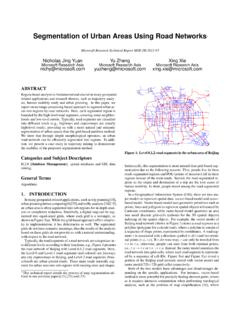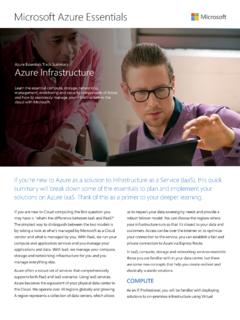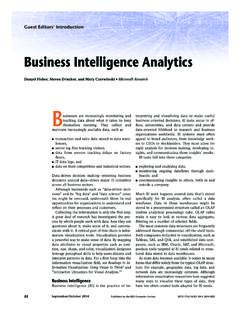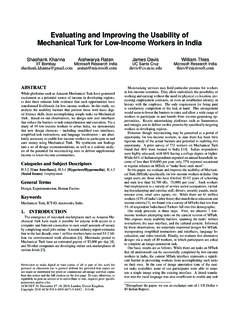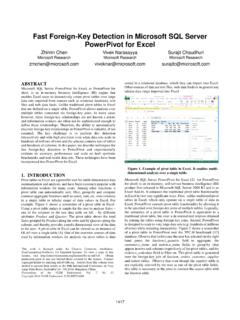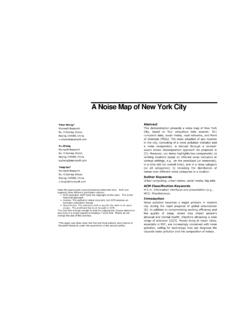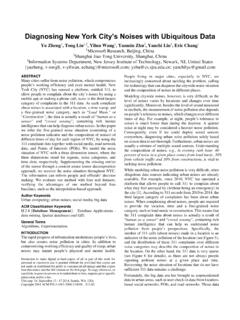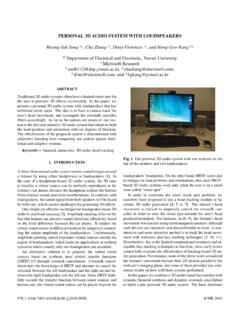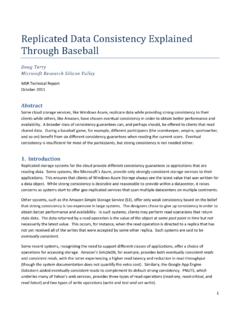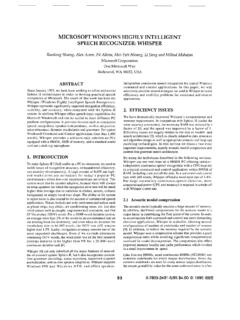Transcription of TrueSkill 2: An improved Bayesian skill rating system
1 TrueSkill 2: An improved Bayesian skill rating systemTom MinkaMicrosoft ResearchRyan ClevenThe CoalitionYordan ZaykovMicrosoft ResearchMarch 22, 2018 AbstractOnline multiplayer games, such asGears of WarandHalo, use skill -based matchmakingto give players fair and enjoyable matches. They depend on a skill rating system to inferaccurate player skills from historical data. TrueSkill is a popular and effective skill ratingsystem, working from only the winner and loser of each game. This paper presents anextension to TrueSkill that incorporates additional information that is readily available inonline shooters, such as player experience, membership in a squad, the number of kills aplayer scored, tendency to quit, and skill in other game modes. This extension, which wecall TrueSkill2, is shown to significantly improve the accuracy of skill ratings computedfromHalo 5matches. TrueSkill2 predicts historical match outcomes with 68% accuracy,compared to 52% accuracy for IntroductionWhen a player wants to play an online multiplayer game, such asHaloorGears of War, theyjoin a queue of waiting players, and a matchmaking service decides who they will play with.
2 Thematchmaking service makes its decision based on several criteria, including geographic locationand skill rating . Our goal is to improve the fairness of matches by improving the accuracy ofthe skill ratings flowing into the matchmaking skill rating of a player is an estimate of their ability to win the next match, based onthe results of their previous matches. A typical match result lists the players involved, theirteam assignments, the length of the match, how long each player played, and the final score ofeach team. A skill rating system must make assumptions about how these match results relateto player skill . We follow previous work by representing these assumptions as a probabilisticgenerative model, that is, a process that generates random player skills and random match resultsfrom the skills. Bayesian inference in this generative model gives the optimal skill ratings underthe skill rating system is only as good as its underlying assumptions.
3 This paper focuses onmaking skill ratings more accurate by making better assumptions. We describe the process by1which we arrived at our generative model, how to evaluate the model, and how to estimate theparameters of the variety of different generative models can be found in previous work. For example, Dan-gauthier et al. [2008] extended TrueSkill for two-player games by giving each player an additionalnumber describing their ability to force draws, which could evolve over time. Glickman [2001]used a model for two-player games where each player has an additional number describing theirskill volatility, which could evolve over time. Chen et al. [2016] used a model where each playerhad a different (but unchanging) skill rating for each character that they could play in the et al. [2006] used a model that accounted for map and server effects on the outcome ofmatches. Chen and Joachims [2016] used a model where skill rating was a vector of numbers,to allow intransitive dominances between , none of these models have the qualities needed by a modern game consulting with the makers ofGears of WarandHalo, we have found that their toppriorities are:1.
4 Support for team games. The system should support matches with any number of teamsand any number of players on each Changeable skill ratings. It must be possible for a player s skill rating to change, nomatter how many matches they have played in the past. This ensures that players receivemeaningful feedback on their Compatibility with an existing matchmaker. Existing matchmakers assume skill is de-scribed by a single number. Players can easily understand a single ordered skill Aligned incentives. The skill rating system should create incentives that align with thespirit of the game. For example, consider a team game where players cooperate to achievea goal. An improperly-designed skill rating system could encourage players to impede theirteammates. As another example, consider a system that increased skill rating accordingto the number of times a player healed themselves.
5 This creates an incentive for a playerto repeatedly injure themselves so that they could be healed. In general, the more controlthat a player has over a quantity, the less useful it is for skill Minimal training data requirements. The most important time to have good matchmakingis immediately after the launch of a game. Unfortunately, this is also when there is theleast amount of data available to train a model. Even if the game has a large player base,there tends to be a small amount of training data per Low computational cost. skill updates are done on servers hosted by the game studio, andskill ratings are stored in a database hosted by the game studio. This means that skillrepresentations should be small and updates should be Minimal tuning. Game studios generally do not have personnel with the knowledge andfree time available to tune the skill rating system after launch. But they do make plentyof other changes to the game, such as adding new game modes, new player abilities, and2re-balancing game mechanics.
6 The skill rating system needs to automatically adapt tothese kinds of solution is to start with the TrueSkill model, which already enjoys properties 1 6, and makejudicious changes that preserve these properties. A skill rating in TrueSkill2 is a single numberwith the same meaning (in terms of win rate) as a TrueSkill rating . Thus any matchmakerthat accepts classic TrueSkill ratings also accepts TrueSkill2 ratings. TrueSkill2 only changesthe way that skills are inferred from historical data. Property 7 is achieved by performingautomatic parameter estimation over a batch of historical data. TrueSkill2 operates in twomodes: an online mode that only propagates skill ratings forward in time, and a batch modethat infers parameters and skills over all time (also known as TrueSkill Through Time). Bothmodes are based on the same probabilistic generative model they only correspond to differentapproximations to the Bayesian , the classic TrueSkill model makes the following assumptions:1.
7 Each player has a latent skill value that represents their expected contribution to a player s performance in a game is a noisy sample of their The performance of a team is the weighted sum of the performances of its players, wherethe weight is the fraction of time the player spent on the If a team s performance is greater than the other team by a certain margin, the team , the game is a draw. When learning skills from data, only the team win/lossinformation is used (not scores).4. Player skills evolve over time according to a random walk. An increase or decrease in skillis assumed equally A player s skill in a game mode is assumed independent of their skill in all other TrueSkill2 model modifies the classic model in the following ways:1. A player s latent skill is inferred from their individual statistics such as kill and deathcounts, in addition to team When a player quits or drops out in the middle of a game, it is treated as a surrender andtheir skill is updated as if they lost a game (regardless of actual outcome).
8 3. A player s skill in a game mode is assumed statistically correlated with their skill in othermodes, so that when a player starts a new mode, their skill rating from other modes The random walk of player skill is assumed biased toward increasing skill , with larger biasduring the first matches a player plays in a game When a player is part of a squad, their performance is assumed to be better than Classic TrueSkillThis section describes the classic TrueSkill model in detail, and sets the notation used in therest of the paper. In the classic TrueSkill model, the data is assumed to consists of a sequenceof match results, each of which lists the players involved, their team assignments, the start timeand length of the match, how long each player played, and the final score of each team. Theteam scores are only used to determine an ordering of best to worst, including interpret this data, TrueSkill assumes a probabilistic generative model of match means that, instead of experimenting with different formulas for updating a player s skillrating and hoping to stumble upon the right one, we construct an intuitive random process forgenerating skills and match results.
9 This model can be checked against data and refined basedon any discrepancies we encounter. When we are happy with the fit to data, we apply Bayesianinference to obtain an optimal algorithm for updating skill generation process is illustrated below, where boxes denote variables that are observedin the data:Past SkillSkillPerformanceTeamPerformanceOthe r teamPerformanceWinnerSkillSkillPerforman cePerformanceThe first step of the generation process is generating the player skills. Each playeriisassumed to have a real-valued skill , denoted skillti, at timet. The initial skill of a player isdrawn from a Gaussian distribution with meanm0and variancev0. This sampling process isdenotedskillt0i N(m0,v0)(1)wheret0is the time of the player s first match and (m0,v0) are tunable parameters. After eachmatch, the player s skill changes by a random amount, also drawn from a Gaussian:skillt+Li N(skillti, 2)after a match of lengthL(2)4(Note that we are talking about the player s actual skill level, not their skill rating assigned bythe system .)
10 In the original paper [Herbrich et al., 2007], this was the only way that a player sskill could change. A later paper [Dangauthier et al., 2008] made the alternative assumption(also made by Glickman [1999]) that a player s skill changed with the passage of time, ratherthan from playing matches:skillt i N(skillti, 2(t t))wheret > t(3)Both of these assumptions make sense, since a player gains experience from each match theyplay, and their sharpness decreases over time without play. Therefore we include both types ofchange in the classic next step of the generation process is generating the match results from the playerskills. TrueSkill assumes that each player has a real-valued performance in each match, drawnaccording to:perfti N(skillti, 2)(4)where is a tunable parameter that reflects the amount of randomness in the game. In thefollowing, we drop the dependence of perfiontsince we are always referring to a specific a two-player game without draws, the winner is the player with the largest performance.
